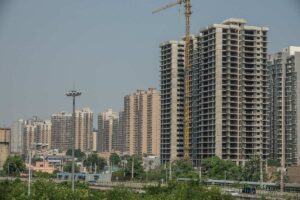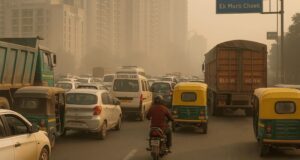
Every flat looks clean. But open the window and wait five minutes. You will see a soft grey layer settling on the table. You wipe it. Then it returns. Again and again. This is not normal dust. This is air filled with construction site particles, moving through Greater Noida like silent fog.
The air smells dry, almost like chalk powder. It comes from cement mixing, cutting tiles, and digging sites where no water is sprinkled and no dust net is used. Trucks move fast on broken roads, lifting clouds that float across balconies and park areas. People do not notice it at first. But this fine construction dust is now part of the air you breathe—at home, on roads, even inside lifts.
What makes it serious is not just the dust, but where it goes. Inside your nose. Into your lungs. On your child’s pillow. And it is getting worse. Places like Noida Extension, Sector 16B, and Techzone 4 are full of new towers coming up—fast and unregulated. And the more they rise, the more this pollution spreads into daily life.
You may not see the harm today. But slowly, this air pollution is turning into a health crisis, hidden in plain sight. And nobody is talking enough about it.
Why Dust Pollution Feels Worse Than Ever in Greater Noida
You clean your floor. You wipe the table. But the dust returns in one hour. This is not regular house dirt. It is construction site dust—a mix of cement particles, brick powder, and sand flakes that float in the air.
This dust comes from open digging, dry sand heaps, and machines that cut marble and tiles. Most sites in Noida Extension do not cover their materials. Trucks go in and out with loose loads. The wind picks up the dust and carries it everywhere.
You can feel it when you walk. The air feels dry and heavy. Your nose tingles. Your eyes burn a little. Even on your balcony, your skin picks up a thin layer.
Why This Area Feels Worse Than Delhi NCR
In Techzone 4, Sector 1, and Gaur City, new towers are rising every day. But many builders do not follow dust control steps. There are no water sprays, no green nets, and no closed storage for cement. This is where the problem starts.
Also, there are very few trees. So when trucks move, the dust goes up—and it has nowhere to settle. It keeps floating. Even flats on 10th or 15th floor get that same powder on grills and glass.
On forums like Noida Extension Flat Owners (NEFOWA) and Gaur City RWA groups, residents have shared videos of thick dust clouds near construction sites. Many parents posted that their kids now cough every night, even with windows shut.
This Is Now an Air Problem, Not Just a Cleanliness Issue
Once dust enters the air, it does not stay outside. It enters your home. It stays on bedsheets. It goes in your throat. This is not just a matter of sweeping more. It is now about what your body is breathing.
In the last two months, Greater Noida AQI (Air Quality Index) has crossed 270 on several days, even without Diwali or smog season. Reports from IQAir show that PM10 levels in Noida West are constantly in the unhealthy range.
People do not talk much about it, but many feel tired without reason. Headaches. Itchy eyes. Dry mouth. These are early signs. The problem is slow, but it is building up inside every flat.
What Residents Say About the Dust Problem
In La Residentia, a woman posted a photo of her floor. She had just mopped it at 10 in the morning. By 12:30, her child’s footprints were clearly visible again in the dust. Many people replied saying this was now normal in their flats too.
In Fusion Homes, a senior citizen wrote,
“Even with windows shut, we see cement dust on the dining table. We clean twice a day. Still the same.”
This kind of air dust from construction is not just on the floor. It stays on fans, curtains, and kitchen racks. It enters your throat without you noticing.
Balcony Time Is No Longer Peaceful
Earlier, residents in Gaur City 2 used to sit on balconies in the evening. Now many say they avoid it. A layer of grey dust settles on chairs and grills within minutes.
One parent from Exotica Dreamville wrote that their daughter now avoids playing outside. Her asthma worsened in the past 2 months. The doctor asked if she was living near construction work. The answer was yes.
Even people without health issues now say they feel a burning nose after evening walks. In summer, with all windows open, there is no way to stop the dust.
Society Groups Are Full of Complaints, But Builders Stay Silent
On WhatsApp groups and RWAs in Cherry County, Panchsheel Greens, and ACE City, residents keep sharing dust videos. People tag builders. They ask for water sprays. They demand dust nets. But most builders do not reply.
In one group, an RWA member said:
“We cannot force the builder. GNIDA should act. But no one comes to check.”
Even though the UP Construction Regulation Rules say dust control is required, many sites simply ignore it. And the dust keeps rising. The complaints stay on WhatsApp only.
How Construction Dust Travels and Enters Your Home
In Greater Noida, especially around Noida Extension, most construction happens in open spaces. Trucks move in and out with uncovered sand, cement bags, and loose bricks. There are no water sprays on roads or piles.
When this dry material sits under sun and wind, it gets light. With one truck passing, the fine dust lifts into the air—just like chalk dust when you slap a board. This is not visible all the time, but it spreads far. It floats, moves with breeze, and settles wherever the wind slows down.
People think dust falls near the site only. But no. It moves across roads, climbs up to higher floors, and gets pulled inside houses through every gap.
Your Home Is Full of Entry Points You Never Think About
Most flats in Techzone 4, Sector 1, and Noida West have small ventilation gaps, bathroom windows, or loose door edges. Even if windows are shut, dust enters through AC ducts, vent grilles, and balcony cracks.
You may not feel the air moving, but it does. And with that, PM10 particles and cement dust settle on beds, floors, and kitchen counters. One resident in Amrapali Zodiac said their kitchen slab always feels dusty by evening—even with closed doors.
Once It Enters, It Stays and Keeps Circulating
The problem is not just entry. It is also about what happens after. Fans and coolers move air around the room. With that, the fine particles stay in motion. You breathe them while you sleep, while you eat, while you speak.
Unlike mud, this dust does not settle fully. It is light, dry, and stubborn. Normal sweeping does not catch it. Even after wet mopping, it returns in hours. This is why people in Gaur City say they feel like cleaning never ends.
What Makes It Worse in Noida Extension Right Now
In Greater Noida West, towers are rising fast, but green spaces are not growing with them. Large plots are being cleared, but nothing is planted back. Open grounds stay dry, dusty, and uncovered for months. In Techzone 4, construction activities have been penalized for violating dust control norms.
Areas like Sector 16C, Noida Extension, and Techzone 7 have long rows of bare construction plots. Without trees or grass, dust has no blocker. It lifts easily and moves across lanes, especially in hot afternoons.
One look from your balcony is enough. You will see open plots where trucks move, loaders shift gravel, and cement piles stay exposed—with zero dust nets and no green cover in sight.
Builders Are Ignoring Dust Rules, Openly
According to the Uttar Pradesh Dust Pollution Control Guidelines (2020), builders must cover material, sprinkle water twice a day, and place green nets around construction. But in most Greater Noida sites, these steps are missing.
You can walk past projects in Panchsheel Greens 2 or Supertech Eco Village, and see open cement piles, brick dust, and raw tile stacks under the sun. No sprinkling. No cover.
RWAs have sent pictures to GNIDA and tagged authorities on X (Twitter). But in most cases, there is no reply. The rules are written—but not followed.
Roads Add More Dust to the Air
Roads near construction sites are often damaged and dry. Cracked footpaths, potholes, and loose road edges break easily when trucks pass. These loose parts turn to dust, mix with construction debris, and stay on the surface.
Then comes the next vehicle. Dust rises again. There is no road cleaning truck. No water. No barrier. In places like Bisrakh Road, Ek Murti Circle, and Surajpur Link, people say the air turns visibly grey during peak construction hours.
When you walk, you breathe it. When you ride a scooty, your shirt turns brown. Even local shopkeepers keep cloths to cover food trays from flying dirt.
Is Your Air Safe to Breathe Indoors?
Many families in Greater Noida West believe that shutting windows will keep the dust out. But that is not working anymore. Even with all windows sealed, people are finding dust inside kitchen drawers, under beds, and on dining tables.
Recent data indicates that Greater Noida’s PM2.5 levels are significantly above the WHO’s recommended limits.
This happens because the fine construction dust moves through bathroom vents, loose AC panels, and even small balcony cracks. In flats around Cherry County and Fusion Homes, residents now keep bedroom doors shut—but the dust still enters.
One woman in Ajnara Le Garden shared online that her toddler’s toys, kept in a closed box, still had a fine grey layer every two days. And this is inside a 13th-floor flat.
You Breathe More Dust Than You See
The air inside your home feels calm. But the dust is still there. It is light. It moves when fans are on. It stays on your bedsheet. You breathe it while sleeping.
Residents in Gaur City 1 reported that AC filters now turn black within 3 weeks. Earlier, it took months. This change shows that the indoor air is now full of tiny dust particles, even though you may not always see them.
These are not heavy dirt flakes. They are PM10-level particles, which stay suspended. You cannot wipe them all. And they reach your lungs much faster than outdoor dust.
Every Room Becomes a Trap Without Air Cleaning
Once dust enters, it does not go out easily. It hides on fans, curtains, and inside pillow covers. And then it keeps circulating.
Most families do not have air purifiers. Even those who do say they need to clean the filters daily. One father in Mahagun Mywoods shared that he bought two purifiers, but the child’s cough still continues. His doctor said:
“It is not about the room. It is about the building dust all around.”
Some people use wet mops three times a day. But the dust keeps returning.
Health Impact Most People Do Not Notice
In many flats across Noida Extension, parents have noticed something strange. Their kids get a light cough. It stays for days. Then weeks. No fever. No cold. Just a dry cough that comes at night and early morning.
This is how dust-triggered respiratory stress starts. Doctors at Yatharth Hospital and Fortis Noida have said that exposure to PM10 and PM2.5 particles can slowly irritate the throat and lungs, especially in children.
A resident of ACE City wrote that their 8-year-old now wakes up coughing at 3 AM. The doctor ruled out infection. The reason? Fine construction dust entering the flat even with windows shut.
Tiredness and Headaches with No Clear Cause
People often feel tired. But in Greater Noida West, many now report daily fatigue, mild headaches, and eye irritation—even without any illness.
This is because of long-term low-grade dust inhalation. When your body breathes suspended particles all day, it gets inflamed. You may not feel sick. But you feel drained. You lose focus. Your eyes itch. Your sleep is poor.
A woman in Exotica Dreamville shared in her RWA group:
“My 65-year-old mother now feels dizzy by evening. Her BP is normal. But her breathing is shallow when we step out on the balcony.”
Even Healthy Adults Are Feeling It
Not just kids and elders. Young adults—those with no history of asthma—are now getting sore throats, skin dryness, and even nosebleeds.
In Fusion Homes, a software engineer said that every day after returning from work, his eyes burn for one hour. He works indoors. But he still walks 10 minutes to reach his flat. That is enough exposure.
Doctors say this is because dry dust with silica or cement particles can irritate mucous membranes—even without high AQI days. The symptoms are slow. But they build over time.
What Can Be Done by You and Your RWA
You cannot stop dust from coming. But you can stop it from staying. Most families in Noida Extension now use a few daily steps:
- Wet mopping twice a day, especially near windows and balconies
- Keep a bowl of water near fans to catch suspended dust
- Place indoor plants like areca palm and snake plant in rooms—they help clean air
- Use microfiber cloths to clean furniture (they trap more dust)
- Keep shoes outside the main door to avoid bringing in fine particles
In societies like Cherry County and SKA Greenarch, these small habits are now common. Residents say they feel a difference in indoor freshness.
2. RWAs Can Push Builders to Act
RWAs in Gaur City 2, Mahagun Mywoods, and La Residentia have started writing formal dust control requests to builders. These letters ask for:
- Regular water sprinkling on roads and open plots
- Green net fencing around construction sites
- Closed trucks for cement and sand transport
- Clear timing limits to reduce night-time mixing and tile cutting
In some places, RWAs also posted dust videos on Twitter tagging GNIDA and local MLA handles. This public pressure forced some builders to start light spraying near active gates.
3. Use Air Monitors to Show Proof
When RWAs complain without data, builders ignore it. But now, people are using portable AQI meters to measure PM2.5 and PM10 levels inside their flats and at balconies.
In Techzone 7, a group of 10 residents collected air readings for a week. They showed the average indoor PM10 was above 200 µg/m³—even with closed doors. With this data, they got media attention and GNIDA inspection.
Many RWAs now share data logs monthly. This makes the issue serious and visible with numbers.
Who Should Take Real Responsibility
You see the dust flying. You feel it in your throat. You clean the same corner five times a day. But the builders stay silent. The authorities do not reply. Most construction sites in Greater Noida are openly flouting pollution control rules. And there is no inspection team on the ground.
According to GNIDA construction rules, every builder must spray water, cover trucks, and follow dust management protocols. But across Techzone 4, Sector 1, and Gaur City, these steps are missing. RWAs send videos. Residents file complaints. But the system just looks the other way.
It is time for change. But that change will not come unless residents speak together. The dust will not wait. It is already inside your home. The violations are real. The ignored complaints are piling up.
The next step must be a collective voice. RWAs must document air quality. Local pages must tag GNIDA, share builder names, and post data online. Let there be record of every ignored inspection notice. Because if no one takes responsibility, the burden will stay on your lungs—and on your child’s breath.
What You Can Do Today to Breathe Cleaner Air
The dust is here. It is in the wind, on your pillow, inside your child’s toy box. But you are not helpless. Small steps work. Wet mopping. Indoor plants. Covered balconies. These protect your home today. Sharing air readings, tagging builder names, speaking in RWAs—this protects your block tomorrow.
You do not need to wait for a rule to be enforced. You need to show what is already broken. In Greater Noida, the problem is visible. But now, it must also be heard. Because clean air is not a luxury. It is your right. And you have the power to ask for it—clearly, calmly, together.

 Greater Noida
Greater Noida

